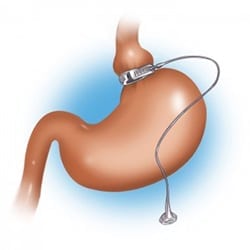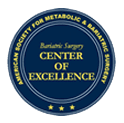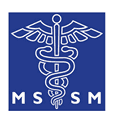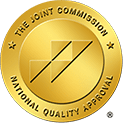 Adjustable gastric banding is considered to be the least invasive weight loss surgery. The purpose of the band is to limit the amount of food you eat, making you feel full with small amounts of food. Since the band is adjustable, your surgeon will be able to adjust it as needed after your procedure to allow food to pass more quickly or slowly through your stomach.
Adjustable gastric banding is considered to be the least invasive weight loss surgery. The purpose of the band is to limit the amount of food you eat, making you feel full with small amounts of food. Since the band is adjustable, your surgeon will be able to adjust it as needed after your procedure to allow food to pass more quickly or slowly through your stomach.
Is Gastric Banding Right For You?
Gastric banding may be an option for you if you are severely obese and have been unsuccessful losing weight, despite making changes to your diet and exercise regimen.
 Your body mass index (BMI) is taken into account to determine eligibility. If your BMI is above 40 – which calculates to roughly 100 pounds overweight for men and 80 pounds for women – then you might be a candidate. Or you may qualify if your BMI is above 35 and you have been diagnosed with a serious obesity-related medical condition such as diabetes, high blood pressure, high cholesterol, heart disease, sleep apnea, etc.
Your body mass index (BMI) is taken into account to determine eligibility. If your BMI is above 40 – which calculates to roughly 100 pounds overweight for men and 80 pounds for women – then you might be a candidate. Or you may qualify if your BMI is above 35 and you have been diagnosed with a serious obesity-related medical condition such as diabetes, high blood pressure, high cholesterol, heart disease, sleep apnea, etc.
During your consultation, your doctor can help you to determine if you are a candidate for this type of weight loss surgery based on your current health and medical history.
How Does It Work?
 This surgical procedure is performed laparoscopically, making small incisions in your abdomen. Your surgeon will then insert a tiny camera (laparoscope), which is connected to a video monitor, and necessary instruments to view your stomach and perform the procedure.
This surgical procedure is performed laparoscopically, making small incisions in your abdomen. Your surgeon will then insert a tiny camera (laparoscope), which is connected to a video monitor, and necessary instruments to view your stomach and perform the procedure.
During the procedure, a soft silicone ring implant with an expandable balloon in the center is placed around the top part of your stomach. This creates a much smaller stomach pouch above the band. When you eat, you will only fill this smaller pouch. After eating, food passes through the opening of the band and into the remaining portion of your stomach where digestion occurs naturally.
To allow for adjustments, the band is attached to an injection port that is placed beneath your skin. Even after losing weight, this port is not visible. Adjustments can easily be performed in your surgeon’s office with no special preparation or additional procedure necessary. To make an adjustment, your surgeon simply accesses the port. To make the passage of food from the top of your stomach to the remaining portion slower, saline is added. Removing saline allows for quicker passage of larger food particles.
After Your Procedure
 This is an outpatient procedure, so you will typically go home the same day as your surgery. As the procedure was performed laparoscopically, many patients return to their regular daily activities in two to four weeks.
This is an outpatient procedure, so you will typically go home the same day as your surgery. As the procedure was performed laparoscopically, many patients return to their regular daily activities in two to four weeks.
You can recover more quickly by remaining active after surgery. During the first week, it is recommended to take short walks. Getting up and moving may help any belly pain you are having as well. But remember, if you hurt while doing something, stop doing that activity and talk to your doctor.
Care for your surgical area as directed by your surgeon. Dressings should always be kept clean and dry. It is normal to have slight bruising and mild redness around your incisions, even though they are small. You will likely have belly pain for the first week or so and may be discharged with a prescription for pain medication.
Your surgeon will likely advise you to consult with a dietitian or nutritionist to learn how to eat correctly with your smaller stomach and help you with meal planning.
For the first two to three weeks after your procedure, you will eat only liquid or pureed food. Slowly you will add soft foods, then progress to regular foods. When you begin to eat regular or solid foods you will likely feel full after just a few bites. This is because your new stomach can only hold approximately one tablespoonful of food.
Over time, your pouch may get larger, but it won’t hold more than one cup of chewed food. A normal-sized stomach can hold up to four cups of chewed food.
For successful weight loss, you will still need to make changes to your diet and exercise habits after surgery. You should eat a healthy diet, remaining mindful of your portion sizes to prevent overeating, as this may cause your stomach to stretch.
The expected recovery and instructions for post-surgical care can vary with each patient. It is important to follow the instructions provided to you by your doctor and to call if you have any questions.
Reported Results
 For the first three to six months, many patients find that the initial weight comes off quickly. Reports of weight loss have shown that after gastric banding, patients lose between one-third and one-half of their excess weight. Weight loss should continue for up to three years. Of course, these results can vary according to how closely you follow your new eating guidelines.
For the first three to six months, many patients find that the initial weight comes off quickly. Reports of weight loss have shown that after gastric banding, patients lose between one-third and one-half of their excess weight. Weight loss should continue for up to three years. Of course, these results can vary according to how closely you follow your new eating guidelines.
If enough weight is lost, you may notice improvement in many different areas, including:
- Arthritis
- Sleep apnea
- Asthma
- Type 2 diabetes
- High cholesterol
- High blood pressure
- Gastroesophageal reflux disease (GERD)
Benefits of Gastric Banding
One benefit of gastric banding is that your band is adjustable. Adjusting the band periodically helps ensure you feel satisfied when you eat and helps you continue with gradual weight loss, approximately one to two pounds per week.
You will also achieve and maintain a healthier weight. Patients who received gastric banding were able to reduce their BMI from 44 to 36 in the first year following surgery in a 3-year clinical trial. These patients were also able to maintain weight loss through the third year.
Possibly the most important benefit that you can expect is a better quality of life. It has been reported that after gastric banding, patients: felt better, engaged in more physical and recreational activities, had more self-confidence and an enhancement in productivity.
To learn more about this type of weight loss surgery, and to inquire about other variations of weight loss surgery and how they could benefit you, contact our office today for a consultation.







